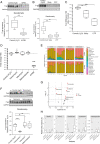Gut microbiota regulation of P-glycoprotein in the intestinal epithelium in maintenance of homeostasis
- PMID: 34493329
- PMCID: PMC8425172
- DOI: 10.1186/s40168-021-01137-3
Gut microbiota regulation of P-glycoprotein in the intestinal epithelium in maintenance of homeostasis
Abstract
Background: P-glycoprotein (P-gp) plays a critical role in protection of the intestinal epithelia by mediating efflux of drugs/xenobiotics from the intestinal mucosa into the gut lumen. Recent studies bring to light that P-gp also confers a critical link in communication between intestinal mucosal barrier function and the innate immune system. Yet, despite knowledge for over 10 years that P-gp plays a central role in gastrointestinal homeostasis, the precise molecular mechanism that controls its functional expression and regulation remains unclear. Here, we assessed how the intestinal microbiome drives P-gp expression and function.
Results: We have identified a "functional core" microbiome of the intestinal gut community, specifically genera within the Clostridia and Bacilli classes, that is necessary and sufficient for P-gp induction in the intestinal epithelium in mouse models. Metagenomic analysis of this core microbial community revealed that short-chain fatty acid and secondary bile acid production positively associate with P-gp expression. We have further shown these two classes of microbiota-derived metabolites synergistically upregulate P-gp expression and function in vitro and in vivo. Moreover, in patients suffering from ulcerative colitis (UC), we find diminished P-gp expression coupled to the reduction of epithelial-derived anti-inflammatory endocannabinoids and luminal content (e.g., microbes or their metabolites) with a reduced capability to induce P-gp expression.
Conclusion: Overall, by means of both in vitro and in vivo studies as well as human subject sample analysis, we identify a mechanistic link between cooperative functional outputs of the complex microbial community and modulation of P-gp, an epithelial component, that functions to suppress overactive inflammation to maintain intestinal homeostasis. Hence, our data support a new cross-talk paradigm in microbiome regulation of mucosal inflammation. Video abstract.
Keywords: Endocannabinoid; Inflammation; Inflammatory bowel diseases; Intestinal epithelium; Microbiome; Multi-drug resistance transporter; P-glycoprotein; Secondary bile acids; Short-chain fatty acids; Ulcerative colitis.
© 2021. The Author(s).
Conflict of interest statement
B.A.M. and R.J.M. are coinventors on a patent application (PGT/US 18/42116) emanating, in part, from the findings described herein. They, along with their respective academic institutions, stand to gain financially through potential commercialization outcomes resulting from activities associated with the licensing of that intellectual property.
Figures






Similar articles
-
Microbial Metabolites Orchestrate a Distinct Multi-Tiered Regulatory Network in the Intestinal Epithelium That Directs P-Glycoprotein Expression.mBio. 2022 Aug 30;13(4):e0199322. doi: 10.1128/mbio.01993-22. Epub 2022 Aug 15. mBio. 2022. PMID: 35968955 Free PMC article.
-
Isoorientin Alleviates DSS-Treated Acute Colitis in Mice by Regulating Intestinal Epithelial P-Glycoprotein (P-gp) Expression.DNA Cell Biol. 2024 Oct;43(10):520-536. doi: 10.1089/dna.2024.0101. Epub 2024 Aug 26. DNA Cell Biol. 2024. PMID: 39180442
-
Alzheimer's Disease Microbiome Is Associated with Dysregulation of the Anti-Inflammatory P-Glycoprotein Pathway.mBio. 2019 May 7;10(3):e00632-19. doi: 10.1128/mBio.00632-19. mBio. 2019. PMID: 31064831 Free PMC article.
-
Development, validation and implementation of an in vitro model for the study of metabolic and immune function in normal and inflamed human colonic epithelium.Dan Med J. 2015 Jan;62(1):B4973. Dan Med J. 2015. PMID: 25557335 Review.
-
Impact of Bacterial Metabolites on Gut Barrier Function and Host Immunity: A Focus on Bacterial Metabolism and Its Relevance for Intestinal Inflammation.Front Immunol. 2021 May 26;12:658354. doi: 10.3389/fimmu.2021.658354. eCollection 2021. Front Immunol. 2021. PMID: 34122415 Free PMC article. Review.
Cited by
-
Membrane transporters in drug development and as determinants of precision medicine.Nat Rev Drug Discov. 2024 Apr;23(4):255-280. doi: 10.1038/s41573-023-00877-1. Epub 2024 Jan 24. Nat Rev Drug Discov. 2024. PMID: 38267543 Free PMC article. Review.
-
The Effect of Gut Microbiome Perturbation on the Bioavailability of Glycyrrhizic Acid in Rats.Pharmaceutics. 2025 Apr 1;17(4):457. doi: 10.3390/pharmaceutics17040457. Pharmaceutics. 2025. PMID: 40284452 Free PMC article.
-
Faecalibacterium prausnitzii Attenuates CKD via Butyrate-Renal GPR43 Axis.Circ Res. 2022 Oct 14;131(9):e120-e134. doi: 10.1161/CIRCRESAHA.122.320184. Epub 2022 Sep 27. Circ Res. 2022. PMID: 36164984 Free PMC article.
-
Power in Numbers: The Gut Microbiome Takes the Spotlight.Chem Res Toxicol. 2022 Feb 21;35(2):112-114. doi: 10.1021/acs.chemrestox.1c00344. Epub 2021 Dec 22. Chem Res Toxicol. 2022. PMID: 34936764 Free PMC article.
-
Gut microbiome modulates tacrolimus pharmacokinetics through the transcriptional regulation of ABCB1.Microbiome. 2023 Jul 6;11(1):138. doi: 10.1186/s40168-023-01578-y. Microbiome. 2023. PMID: 37408070 Free PMC article.
References
-
- Pazos M, Siccardi D, Mumy KL, Bien JD, Louie S, Shi HN, Gronert K, Mrsny RJ, McCormick BA. Multidrug resistance-associated transporter 2 regulates mucosal inflammation by facilitating the synthesis of hepoxilin A3. J Immunol. 2008;181(11):8044–8052. doi: 10.4049/jimmunol.181.11.8044. - DOI - PMC - PubMed
-
- Szabady RL, Louissaint C, Lubben A, Xie B, Reeksting S, Tuohy C, Demma Z, Foley SE, Faherty CS, Llanos-Chea A, Olive AJ, Mrsny RJ, McCormick BA. Intestinal P-glycoprotein exports endocannabinoids to prevent inflammation and maintain homeostasis. J Clin Invest. 2018;128(9):4044–4056. doi: 10.1172/JCI96817. - DOI - PMC - PubMed
Publication types
MeSH terms
Substances
Grants and funding
LinkOut - more resources
Full Text Sources
Miscellaneous

